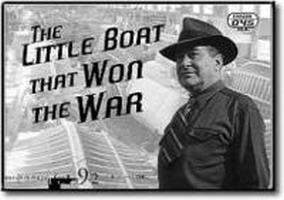 I am aware of only one man who was praised by both Eisenhower and Hitler. A repost on the anniversary of D-Day.
I am aware of only one man who was praised by both Eisenhower and Hitler. A repost on the anniversary of D-Day.
General Dwight David Eisenhower said that “Andrew Higgins … is the man who won the war for us. … If Higgins had not designed and built those LCVPs, we never could have landed over an open beach. The whole strategy of the war would have been different.” Adolph Hitler referred to Andrew Higgins as the “new Noah,” though his admiration was more begrudging. On the 74th anniversary of the Normandy landings, better known as D-Day, it seems worthwhile to remember Andrew Higgins and the amazing Higgins boat.
Andrew Jackson Higgins was a high school drop-out from Nebraska, who came to New Orleans, Louisiana to get into the timber business. He soon branched out to building boats which operated in the shallow waters of the swamps, hauling out felled trees. Prior to World War II, the Navy’s landing craft were antiquated and cumbersome. Higgin’s design, based on his shallow water work boats, proved superior, despite objections by the Naval Bureau of Construction and Repair. The Marine Corps was major supporter of the Higgins’ design because it was simply better than anything that the Navy had to offer.
The first boat, dubbed Landing Craft Personnel (Large) or LCP (L), still required the soldiers on board to disembark by jumping over the bow or the sides. Inspired by a Japanese landing craft design, Higgins added a bow ramp to his design, allowing 36 fully equipped soldiers to charge down the ramp onto the beach as soon as the ramp was dropped. The design, dubbed Landing Craft, Vehicle, Personnel (LCVP), but better known simply as the Higgins boat, would change the course of the war, allowing amphibious landings over open beaches without the need to capture deep water ports. The D-Day landings in Normandy would not have been possible without the Higgins boat.
The Higgins boats were only 36′ long with a 10′ beam. They were built of plywood with a steel ramp door. Despite their small size, the boat could carry 36 men or a jeep and 12 men, or 8,000 pounds of cargo. A larger variant, the LCM, Landing Craft Mechanized could carry a tank.
The Higgins boats led amphibious operations including Operation Overlord on D-Day in Nazi German occupied Normandy, was well as Operation Torch in North Africa, the Allied invasion of Sicily, Operation Shingle and Operation Avalanche in Italy, Operation Dragoon, and in the Pacific Theatre at the Battle of Guadalcanal, the Battle of Tarawa, the Battle of the Philippines, the Battle of Iwo Jima and the Battle of Okinawa.
More than 20,000 Higgins boats were built by Higgins Industries and licensees.

Can you say “editor”?
Read the last line, “More than 20,000 Higgins boats were built by Higgins Industries and licensees.ere built by Higgins Industries and licensees,” very carefully.
The famous S&S yacht design studio run by the famous Stevens brothers. Olin was well know for fast and beautiful racing yachts but Rod Stevens, his less acclaimed but equally talented brother, designed the DUKW “Duck”, a pretty handy vessel with a proven track record.
From Wikipedia:
“The term DUKW is not an acronym, but rather the original GMC nomenclature designating the company’s manufacturing code for the military wheeled amphibious landing-craft — with D standing for 1942, U for utility (amphibious), K for all-wheel drive, and W for 2 powered rear axles.”
I see they fixed the last line. They’re hardly alone. I sometimes wonder if people ever read before they post.
Drake Sparkman, and the Stephens brothers (please note the correct spelling): Olin J Stephens II and Roderick Stephens were the back bone of Sparkman and Stephens from the late 20’s to their retirements. All are dead now but Olin and Rod were two of the most talented and creatives yacht designers (as well as vessels for the military and for commercial purposes) ever, and certainly at the very top of the list of American practitioners of that trade. The LCVP figures prominently in the acclaimed TV series THE BOATS THAT BUILT BRITAIN starring Tom Cunliffe, which was a series created for the BBC back around 2009 or so. I have a wonderful photo of Ian MacGillivray (a British sailor and friend of Tom’s) and Tom putting around in a “skip” (British for a dumpster) which had been motorized and fitted to act as a sort of landing craft…………